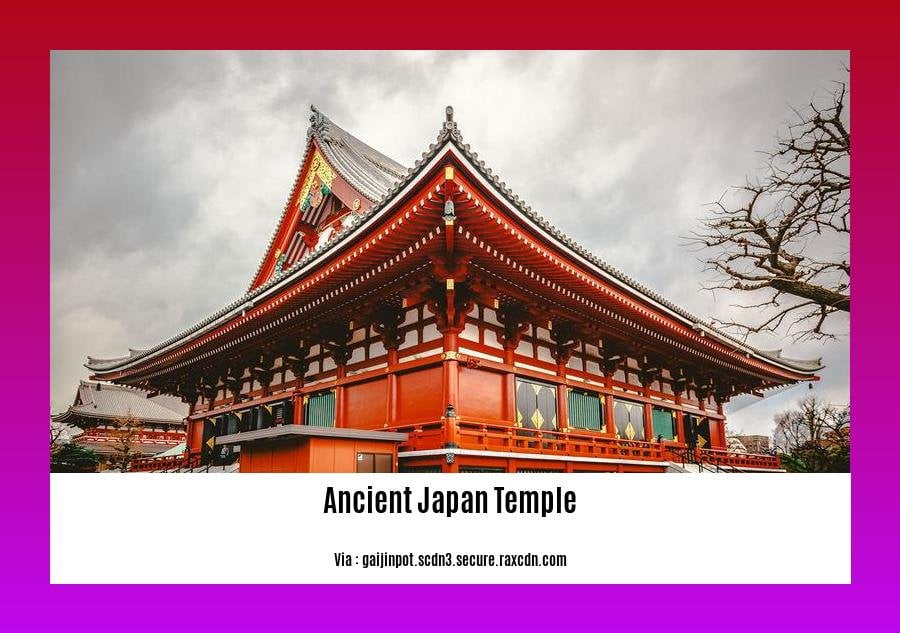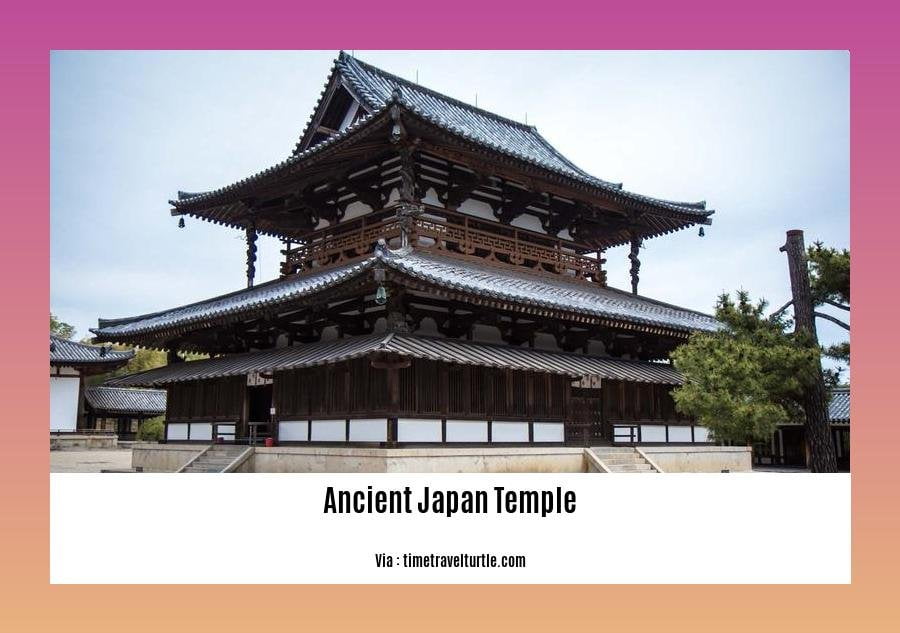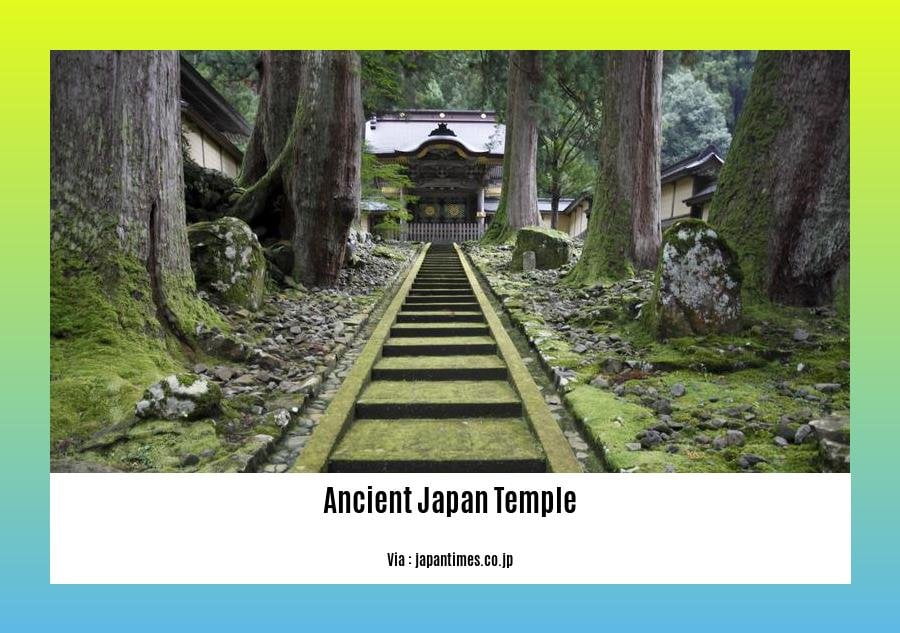Embark on a captivating journey through time as we unveil the secrets of ancient Japanese temples in our article, [Unveiling the Ancient Japan Temples: A Journey Through History, Rituals, and Architectural Splendors]. Discover the profound history, exquisite artistry, and spiritual significance of these sacred havens. Immerse yourself in the rituals, beliefs, and architectural wonders that define these ancient sites, gaining a deeper understanding of Japan’s rich cultural heritage.
Key Takeaways:
-
Izumo Taisha Shrine in Shimane Prefecture is Japan’s oldest and tallest shrine, possibly dating back to ancient times.
-
Byodo-in Temple, built in 998 in Kyoto Prefecture, features the Phoenix Hall, renowned for its 1,000 statues of Buddhist deities.
-
Remarkable temples with significant architectural and historical value include Chuson-ji’s Golden Hall, Zuigan-ji’s Priest’s Quarters and Main Hall, and the Three Mountains of Dewa’s Five-storied Pagoda.
Ancient Japan Temple: A Journey Through History, Rituals, and Architectural Splendors

In the heart of ancient Japan, a realm of intricate history, spiritual rituals, and breathtaking architecture awaits. Like stepping back in time, these ancient Japan temples captivate with their profound tales and exquisite artistry, offering a glimpse into the nation’s cultural and religious roots. From the towering grandeur of Izumo Taisha Shrine, Japan’s oldest and tallest shrine, to the serene beauty of Byodo-in Temple, adorned with a thousand Buddhist deities, these sacred spaces hold a wealth of stories, inviting us on a journey of discovery and enlightenment.
Significance of Ancient Japan Temples
-
Historical Landmarks: Many ancient Japan temples have stood for centuries, witnessing significant events and embodying the nation’s rich past. They serve as tangible links to Japan’s ancient history and culture, providing insights into the lives, beliefs, and practices of past generations.
-
Religious and Spiritual Centers: These temples were, and still are, places of worship and spiritual communion for millions of Japanese people. They embody various religious traditions, including Shintoism, Buddhism, and other ancient beliefs, offering a sanctuary for prayer, meditation, and spiritual practices.
-
Architectural Marvels: Ancient Japan temples showcase exceptional craftsmanship and architectural ingenuity. Their intricate designs, elaborate carvings, and harmonious fusion of natural elements create visually stunning structures that reflect the artistic and aesthetic sensibilities of ancient Japan.
-
Cultural Treasures: Temples often house precious cultural artifacts, such as ancient manuscripts, rare paintings, and exquisite sculptures. These treasures provide valuable insights into Japan’s history, art, and cultural heritage, offering a glimpse into the creativity and artistry of past artisans.
-
Tourist Attractions: Today, many ancient Japan temples have become popular tourist destinations, attracting visitors from around the world. They offer a unique opportunity to immerse oneself in Japan’s rich cultural heritage, appreciate the beauty of traditional architecture, and gain a deeper understanding of Japanese spirituality and beliefs.
Exploring Ancient Japan Temples: A Guide for Visitors
-
Plan Your Visit:
-
Research the temples you wish to visit, their historical significance, and any festivals or events that may coincide with your trip.
-
Check temple hours and admission fees, as some may have specific visiting times or require reservations.
-
Consider purchasing a Japan Rail Pass if you plan to visit multiple temples across different regions.
-
Respect Temple Etiquette:
-
Before entering a temple, cleanse your hands and mouth using the provided water basin.
-
Remove your shoes before stepping onto the temple grounds and place them neatly in the designated shoe rack.
-
Be mindful of your behavior and maintain a respectful silence while inside the temple.
-
Avoid touching or leaning against religious objects or artwork.
-
Explore the Temple Grounds:
-
Take your time to explore the temple’s main building, where the principal deity is enshrined. Admire the intricate carvings, paintings, and other decorative elements.
-
Wander through the temple grounds, marveling at the serene gardens, tranquil ponds, and ancient trees that create a sense of harmony and peace.
-
Participate in traditional rituals, such as writing a wish on an ema (wooden votive plaque) or ringing a bell for good luck.
-
Learn About the History and Significance:
-
Read the information boards and placards that provide historical context and explanations about the temple’s significance and architectural features.
-
Engage with local guides or temple staff who can share insights and stories about the temple’s past and present.
-
Attend festivals or special events held at the temple to experience Japanese culture and traditions firsthand.
-
Capture the Beauty:
-
Take photos to capture the beauty of the temple’s architecture and surroundings, but be respectful of any photography restrictions.
-
Sketch or paint the temple’s scenery to create a unique memento of your visit.
-
Write a journal or blog post about your experience to share your newfound knowledge and appreciation for ancient Japan temples with others.
- Ancient Greek word for power – Explore the origin and variations of the ancient Greek word for power, and delve into its historical significance and cultural context.
- Ancient guardians card list price – Unleash the power of ancient guardians with our comprehensive list of card prices. Discover the value and rarity of these sought-after collectibles.
- Ancient Indian art forms – Journey through the rich tapestry of ancient Indian art forms, from intricate sculptures to vibrant paintings, and explore their profound cultural and spiritual significance.
Rituals and Ceremonies Performed in Ancient Japanese Temples
Embark on a journey through time to ancient Japan, where sacred temples and shrines hold deep spiritual significance. These venerable structures, steeped in history and tradition, serve as gateways to the divine, where rituals and ceremonies unfold, connecting worshippers with the realm of the spirits. Discover the profound meaning and practices behind these ancient rituals, gaining a deeper understanding of Japan’s rich cultural heritage.
Key Rituals and Ceremonies:
- Purification Rituals:
- Ritual: Before entering a temple or shrine, visitors undergo purification rituals to cleanse their body and soul.
-
Practice: Wash hands at a chozuya (ablution fountain) or perform a water purification ritual called temizu. This symbolizes the purification of mind and body, preparing for a spiritual encounter.
-
Offerings and Prayer:
- Ritual: Visitors make offerings to deities enshrined in the temple or shrine.
-
Practice: Offer coins in an offertory box and symbolic items like rice, salt, or sake. Offer prayers, expressing gratitude, seeking blessings, or making requests to the deity.
-
Bowing and Clapping:
- Ritual: Bow reverently to show respect and reverence to the deity.
- Practice: Clap hands twice to attract the deity’s attention and signal presence. Bowing and clapping are integral parts of Japanese religious rituals, honoring divine beings.
Etiquette and Respect:
- Remove shoes before entering a temple or shrine.
- Maintain silence and avoid loud conversations.
- Respect the sacred space and refrain from touching or disturbing offerings.
- Follow the instructions and guidance provided by temple or shrine staff.
Key Takeaways:
- Purification rituals symbolize cleansing of mind and body before entering a sacred space.
- Offerings and prayer are ways to express gratitude, seek blessings, and honor deities.
- Bowing and clapping are integral parts of Japanese religious rituals, showing respect to the divine.
- Observing proper etiquette and respect is essential when visiting temples and shrines.
Relevant Sources:
- Rituals and Customs at Japanese Shrines
- Etiquette at Shrines and Temples: A Step-by-Step Guide
Famous ancient Japanese temples and their unique characteristics

Welcome, fellow explorers, to a journey through the hallowed grounds of Japan’s ancient temples. Prepare to be captivated as we unravel the stories, rituals, and architectural wonders that define these sacred havens.
Kinkaku-ji’s Golden Pavilion: Step into the ethereal beauty of Kinkaku-ji, also known as the Golden Pavilion. Gaze upon its shimmering gold leaf exterior, reflecting perfectly on the mirror pond. Immerse yourself in the serene atmosphere as you wander through the temple grounds, feeling a profound sense of peace and tranquility. [https://www.japan.travel/en/spot/340/]
Ryoan-ji’s Zen Garden: Discover the enigmatic charm of Ryoan-ji’s Zen Garden, renowned for its rock garden. Fifteen stones, meticulously arranged in a bed of gravel, invite contemplation and introspection. Let the simplicity of this garden transport you to a state of mindfulness, encouraging you to find inner peace and tranquility. [
Todai-ji Temple: Journey to Todai-ji Temple in Nara, and marvel at the world’s largest wooden structure. Within its grand halls, you’ll find a colossal bronze statue of Buddha, a testament to Japan’s rich history and religious devotion. Explore the temple complex, immersing yourself in its cultural and spiritual significance.
Kiyomizu-dera Temple: Ascend the iconic wooden stage of Kiyomizu-dera Temple in Kyoto, a UNESCO World Heritage Site. Suspended high above the hillside, this stage offers breathtaking panoramic views of the city. Experience the purity of the temple’s water, said to possess healing properties, as you cleanse your hands and mouth before entering the sacred precincts.
Eikan-do Zenrin-ji Temple: Seek solace and tranquility at Eikan-do Zenrin-ji Temple in Kyoto. Admire the vibrant autumn foliage that paints the temple grounds in hues of red, orange, and gold. Explore the serene Zen garden, allowing your mind to find harmony and balance amidst the natural beauty.
Sanjusangen-do Temple: Prepare to be awestruck by Sanjusangen-do Temple in Kyoto, home to an impressive collection of 1,001 wooden statues of Kannon, the goddess of mercy. Marvel at the intricate details and serene expressions of these sacred figures as you walk through the temple’s long hall.
Byodoin Temple: Travel to Uji, Kyoto Prefecture, and visit Byodoin Temple, a UNESCO World Heritage Site. Its iconic Phoenix Hall, with its elegant architecture and intricate carvings, embodies the pinnacle of Japanese Buddhist art. Stroll through the temple’s beautiful garden, relishing the serene atmosphere that permeates the air.
Yakushiji Temple: Explore Yakushiji Temple in Nara, another UNESCO World Heritage Site. Admire its three-storied pagoda, a symbol of architectural brilliance. Discover the temple’s historical and cultural significance as you wander through its grounds, appreciating its enduring legacy.
Enryaku-ji Temple: Embark on a spiritual journey to Enryaku-ji Temple, nestled atop Mount Hiei. This Tendai Buddhist temple, founded in the 8th century, offers stunning views from its extensive temple complex. Engage with its rich history and religious significance as you explore its numerous halls and pagodas.
Toshogu Shrine: Journey to Nikko to witness the grandeur of Toshogu Shrine, a UNESCO World Heritage Site. Adorned with elaborate decorations and colorful structures, this Shinto shrine is a spectacle to behold. Delve into its fascinating history, learning about the life of Tokugawa Ieyasu, the founder of the Tokugawa dynasty.
Key Takeaways:
– Ancient Japanese temples hold immense historical, religious, and cultural significance, embodying the spiritual heart of Japan.
– Each temple possesses unique architectural features, such as golden pavilions, rock gardens, and towering pagodas, reflecting Japan’s diverse artistic traditions.
– Visitors can immerse themselves in temple rituals, such as purification rites, offerings, and prayers, gaining insights into Japanese religious practices.
– Exploring these temples offers a chance to appreciate Japan’s rich history, cultural heritage, and the enduring legacy of its ancient traditions.
Sources:
– [Japan Travel: https://www.japan.travel/en/]
– [Japan Guide:
How to visit and explore ancient Japanese temples
Have you ever felt the pull of history calling out to you? Yearning to step into the sacred spaces where ancient rituals were performed and marvel at the artistry of yesteryears? Then, let’s embark on a journey through time to explore the ancient Japanese temples, where spirituality and history intertwine.
Key Takeaways:
- Ancient Japanese temples are not just places of worship; they’re living relics of history and culture.
- Proper etiquette and respect for rituals are essential for a fulfilling visit.
- Be prepared to immerse yourself in serene and meditative environments.
- Exploring ancient temples offers insights into the intricate tapestry of Japanese heritage.
1. Plan Your Pilgrimage:
Before you set off on your temple adventure, do some research to identify the ones that align with your interests. Whether it’s the Zen gardens of Kyoto or the UNESCO World Heritage sites of Nara, each temple offers a unique experience. Check temple hours and plan a route that optimizes your time. Plus, consider a Japan Rail Pass if you’re covering long distances.
2. Sacred Etiquette 101:
Remember, ancient temples are hallowed grounds. Show respect by following proper etiquette. Start by removing your shoes before entering the main temple building. Purification rituals are common, so cleanse your hands and mouth at the chozuya (ablution fountain). Maintain a respectful silence and avoid disturbing other visitors.
3. Explore and Discover:
As you enter the temple grounds, take a moment to appreciate the serene atmosphere. Admire the intricate architecture, often adorned with colorful carvings and elaborate decorations. Wander through the gardens, seeking solace in the carefully manicured landscapes. Engage with local guides or read information boards to delve deeper into the temple’s history and significance.
4. Participate in Rituals:
Rituals are the heart of temple life. If you’re lucky, you might witness traditional ceremonies like fire rituals or kagura (sacred Shinto dance). Participate in purification rituals by washing your hands at the chozuya and clapping your hands before praying. These rituals connect you to the spiritual essence of the temples.
5. Capture the Moment:
As you explore, don’t forget to capture the beauty of these ancient structures. Photography is generally allowed, but be respectful of restrictions in certain areas. Sketch or write in a journal to document your experience. The memories you create will last a lifetime.
Relevant URL Sources:
- Etiquette at Shrines and Temples: A Step-by-Step Guide
- Visiting Temples in Japan: A Guide to Etiquette
FAQ
Q1: What is the significance of temples and shrines in ancient Japan?
A1: Temples and shrines in ancient Japan held immense religious and cultural significance. They were considered sacred spaces where people could worship deities, seek spiritual guidance, and participate in various rituals and ceremonies. These sites played a crucial role in shaping the spiritual beliefs and practices of the ancient Japanese people.
Q2: What are some of the unique architectural features of ancient Japanese temples?
A2: Ancient Japanese temples exhibited remarkable architectural features that reflected the country’s rich cultural heritage and craftsmanship. These temples often incorporated intricate carvings, vibrant colors, and elaborate designs. They were constructed using traditional techniques and materials, such as wood and stone, and featured distinct structural elements like curved roofs, pagodas, and elaborate gateways.
Q3: What rituals and practices were performed in ancient Japanese temples and shrines?
A3: Ancient Japanese temples and shrines were centers of various religious rituals and practices. Purification rituals, offerings to deities, and prayers were common practices performed by worshippers. Ritual dances, music, and chanting also played significant roles in these ceremonies. Additionally, festivals and special events were held throughout the year to celebrate deities and commemorate important occasions.
Q4: How did ancient Japanese temples and shrines contribute to the development of the country’s art and culture?
A4: Ancient Japanese temples and shrines served as hubs for artistic expression and cultural development. They were adorned with exquisite artwork, including sculptures, paintings, and calligraphy. The construction and maintenance of these sacred spaces fostered the growth of traditional crafts and techniques, contributing to the flourishing of Japanese arts and culture. Furthermore, temples and shrines often served as centers of learning and education, preserving and transmitting knowledge across generations.
Q5: How can visitors respectfully explore ancient Japanese temples and shrines today?
A5: When visiting ancient Japanese temples and shrines, it is important to show respect for the sacredness of these sites. Visitors should adhere to local customs and etiquette, such as removing shoes before entering, maintaining silence and refraining from disruptive behavior. Proper attire is also essential, with modest clothing that covers shoulders and knees being the norm. Additionally, it is important to respect the privacy of worshippers and avoid disturbing ongoing rituals or ceremonies.
- Unraveling Einstein’s Legacy: Who Inherited His Genius? - July 14, 2025
- Unlock Einstein’s Family Tree: Bernhard Caesar & Untold Stories - July 14, 2025
- Unveiling Bernhard Caesar Einstein: His Life & Albert Einstein’s Legacy - July 14, 2025
















